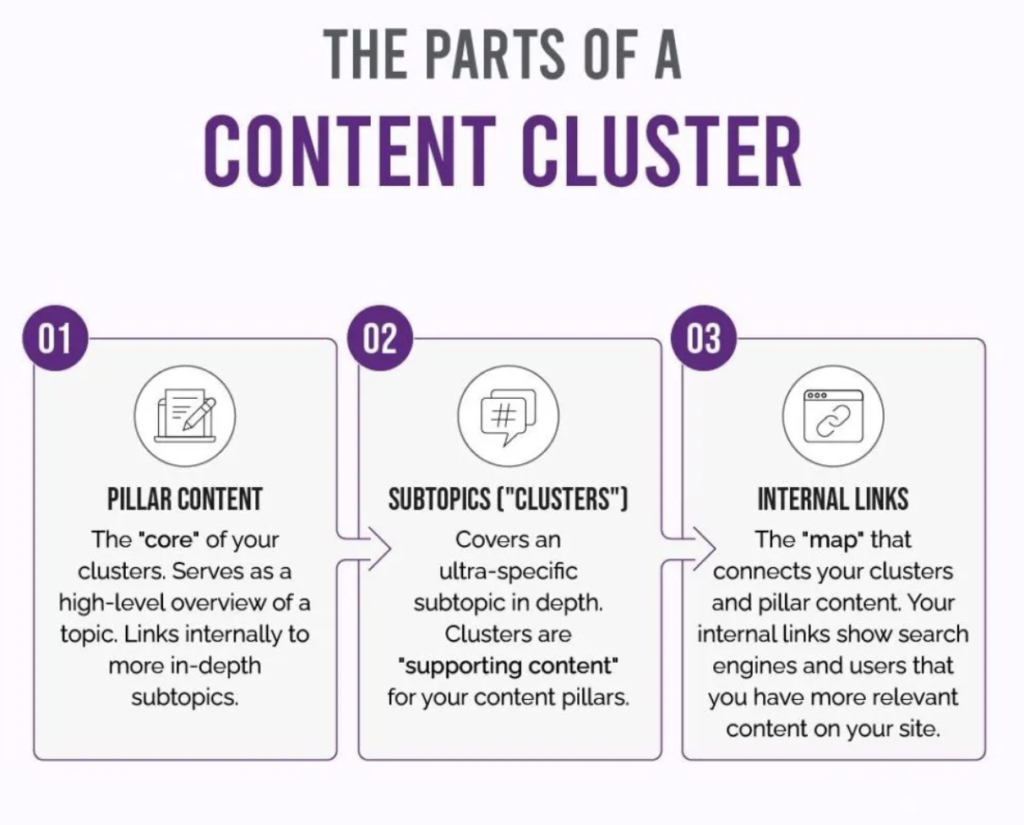Importance of Content Cluster Organization
I’ve found that content cluster organization is vital for both SEO and user experience. It allows me to create a cohesive strategy where related pieces of content are interlinked, helping my audience navigate through my site easily. This organizational method benefits my site’s visibility on search engines by establishing a strong semantic relationship between different content pieces. To learn more about content clusters, just visit my blog page on “What is a Content Cluster?”
The importance is highlighted in three key areas:
- Enhanced Discoverability: Properly organized clusters help search engines understand the context and relevance of my content, boosting rankings.
- Improved User Experience: Users can easily find related information, keeping them engaged longer.
- Content Authority: By clustering related content, I position myself as an authority on specific topics, which builds credibility.
Strategies for Content Cluster Organization
When organizing my content clusters, I utilize several strategies to ensure they are effective and efficient. Here are the key tactics:
- Identify Core Topics: I start by identifying broad, core topics that are crucial to my niche. These core topics will serve as the main hubs of my clusters.
- Create Subtopics: Next, I brainstorm subtopics that fall under each core topic. These subtopics become individual pieces of content that are interlinked with the core topic article.
- Utilize Internal Linking: I make sure to use internal links liberally within my cluster. These links connect subtopic articles back to the core topic, creating a web of interconnected content that users and search engines can easily navigate.
- Use Pillar and Cluster Structure: My content is structured in a “pillar and cluster” model. The pillar page covers the core topic comprehensively, and the cluster content delves into specific aspects.
Here’s a table to illustrate this structure:
| Core Topic | Subtopics | Internal Links |
|---|---|---|
| Content Marketing | Email Marketing, Social Media Strategy, SEO Basics | Links from subtopics back to Content Marketing |
| SEO Techniques | Keyword Research, On-page SEO, Link Building | Links from subtopics back to SEO Techniques |
| Social Media | Facebook Marketing, Instagram Growth, Twitter Ads | Links from subtopics back to Social Media |
- Leverage Data Analytics: I continuously track and analyze the performance of my clusters. This helps me understand which topics resonate most with my audience and which need further optimization. See tracking and analyzing performance for more insights.
For additional details on content clusters, you can refer to my article on what is a content cluster and examples in content cluster examples. These resources offer a deeper dive into creating effective clusters and setting up a robust content cluster strategy.

Content Cluster Organization and Cohesive Content Strategy
A cohesive content strategy goes hand in hand with content cluster organization. Here are the steps I take to ensure that my content clusters are well-structured and highly effective.
Topic Research and Ideation
The first step in creating a cohesive content strategy is thorough topic research and ideation. I start by brainstorming all relevant topics that could fit within my content cluster. Using keyword research tools, I identify high-volume keywords and questions that my audience is asking.
| Topic Idea | Keyword Volume |
|---|---|
| What is a content cluster | 5,000 searches/month |
| Benefits of content clusters | 3,500 searches/month |
| How to create a content cluster | 2,000 searches/month |
For a deeper dive into why these clusters work, check out my piece on what is a content cluster.
Interlinking Content within Clusters
Effective internal linking within content clusters is essential for guiding users through related content and improving SEO. I make sure to interlink articles, blogs, and pages so that they provide additional context and keep readers engaged.
For instance, if I’m writing about the benefits of content clusters, I might link to other relevant topics like content cluster strategy or content cluster examples.
Optimizing for SEO and User Experience
SEO and user experience go hand-in-hand when it comes to content clusters. I always optimize my content for focus keywords, metadata, and alt text for images. Additionally, I ensure the content is readable, well-structured, and valuable for the user.
| SEO Factor | Action |
|---|---|
| Keywords | Use primary and LSI keywords organically |
| Metadata | Optimize title tags, meta descriptions |
| Images | Use descriptive alt text |
For more information on optimizing content clusters for search engines, read my guidelines on content cluster seo.
Tracking and Analyzing Performance
Finally, tracking and analyzing the performance of my content clusters helps me understand what’s working and what needs improvement. I use various analytics tools to monitor metrics like page views, bounce rate, and average time on page.
| Metric | Goal |
|---|---|
| Page Views | 1,000+ per month |
| Bounce Rate | < 50% |
| Average Time on Page | > 2 minutes |
By regularly reviewing these metrics, I can make data-driven decisions to refine my approach and achieve better results.

